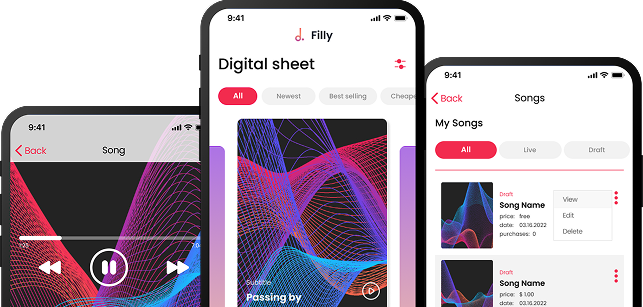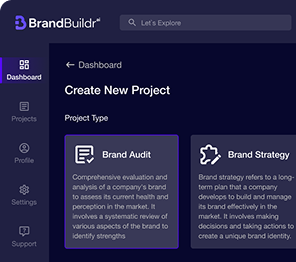According to data from Sensor Tower, global spending on mobile apps is projected to hit $270 billion by 2025. But mobile apps have a high failure rate due to challenges in user adoption. A Mobile Application Development Life Cycle (MADLC) can help mitigate these challenges and increase your chances of success. This article explores best practices within each phase, ensuring your app not only launches but thrives. Learn how Codebridge's expertise guides businesses through this lifecycle, turning innovative ideas into successful mobile solutions.

Mobile Application Development Life Cycle
The Mobile Application Development Life Cycle (MADLC) is a structured, iterative process that outlines the steps involved in creating and maintaining a mobile application. It's not a rigid, linear path, but rather a cyclical approach that allows for continuous improvement and adaptation based on user feedback and market changes.
Adopting a well-defined MADLC offers several key advantages. It reduces development costs by providing a clear roadmap and minimizing wasted effort. It also minimizes risks by identifying potential problems early on and addressing them proactively. Furthermore, a structured MADLC enhances app quality by ensuring that all aspects of the app are thoroughly tested and refined. Finally, it streamlines project management by providing a framework for tracking progress and managing resources effectively. A well-defined MADLC can reduce development costs by up to 30% and significantly improve time to market.
The typical phases of the MADLC include:
- Strategic Planning: Defining the app's purpose and target audience.
- Design: Creating the app's user interface and user experience.
- Development: Building the app's functionality and features.
- Quality Assurance: Testing the app for bugs and ensuring its stability.
- Deployment: Releasing the app to app stores.
- Maintenance: Providing ongoing support and updates.
Strategic Planning and Analysis
The strategic planning and analysis phase is the foundation upon which the entire mobile application is built. This initial phase involves several critical activities, including defining the app's core purpose, identifying the precise target audience, and conducting comprehensive market research.
Establishing a clear and compelling value proposition is paramount. Your value proposition is the cornerstone of your app's success. It should clearly articulate the problem you're solving and the benefits you offer to users. A strong value proposition answers the question: "Why should a user choose my app over the competition?" It should be concise, easy to understand, and focused on the user's needs.
Feasibility studies and competitive landscape analysis are also crucial in validating the app idea. These studies help determine whether the app is technically feasible, financially viable, and whether there is a market demand for it.
In-Depth Market Research: Understanding User Needs
In-depth market research is essential for understanding the needs, preferences, and behaviors of your target audience. This research can involve surveys, interviews, focus groups, and analysis of existing market data. By understanding your target audience, you can tailor your app to meet their specific needs and increase its chances of success. According to Business of Apps, market research is a critical step in understanding user expectations and feature prioritization.
According to Business of Apps, market research is a critical step in understanding user expectations and feature prioritization.
Competitive Analysis: Identifying Market Gaps
A competitive analysis involves identifying and evaluating your competitors' apps. This analysis helps you understand the strengths and weaknesses of your competitors, identify market gaps, and differentiate your app from the competition. By understanding the competitive landscape, you can position your app for success.
Technical Feasibility Assessment: Ensuring Viability
A technical feasibility assessment determines whether your app idea is technically possible to implement. This assessment involves evaluating the available technologies, resources, and expertise required to build the app. It also considers factors such as scalability, security, and performance. By conducting a technical feasibility assessment, you can avoid costly mistakes and ensure that your app is technically viable.
Design and Prototyping Excellence
UX/UI design plays a pivotal role in creating engaging and user-friendly mobile applications. A great UX/UI design can increase user retention by up to 50%. The design phase translates the strategic vision into a tangible blueprint for the app.

The iterative process of crafting wireframes and high-fidelity mockups is essential for visualizing the app's interface and functionality. Wireframes are low-fidelity representations of the app's layout, while mockups are high-fidelity visual designs that show the app's look and feel.
Conducting thorough usability testing is also significant for gathering valuable user feedback and refining the design. Usability testing involves observing users as they interact with the app and gathering feedback on their experience. This feedback can be used to identify usability issues and improve the app's design.
Crafting Intuitive User Experiences (UX)
Crafting intuitive user experiences (UX) involves designing the app in a way that is easy to use and understand. This includes considering factors such as navigation, information architecture, and user flows. The goal is to create an experience that is seamless, efficient, and enjoyable for the user.
Designing Captivating User Interfaces (UI)
Designing captivating user interfaces (UI) involves creating a visually appealing and engaging design that reflects the app's brand and personality. This includes considering factors such as color palettes, typography, imagery, and animations. The goal is to create a design that is both aesthetically pleasing and functional.
Validating Designs Through Prototyping and Usability Testing
Validating designs through prototyping and usability testing is crucial for ensuring that the app meets the needs of its users. Prototyping involves creating interactive models of the app that can be tested with users. Usability testing involves observing users as they interact with the prototype and gathering feedback on their experience.

Development and Implementation Strategies
There are various approaches to mobile app development, including native, hybrid, and cross-platform. Native apps offer superior performance, while cross-platform frameworks can be more cost-effective for initial development. Native apps are built specifically for a particular operating system (e.g., iOS or Android), while hybrid and cross-platform apps are built using web technologies and can run on multiple operating systems.
Selecting the optimal technology stack is also important, based on project requirements and budget constraints. The technology stack includes the programming languages, frameworks, and tools used to build the app.
The core development processes include coding the frontend and backend, integrating APIs, and building robust data models.

Frontend Development: Creating the User Interface
Frontend development involves creating the user interface (UI) of the app. This includes coding the visual elements of the app, such as buttons, text fields, and images. Frontend developers use languages such as HTML, CSS, and JavaScript to build the UI.
Backend Development: Powering the App Logic
Backend development involves building the server-side logic of the app. This includes handling user authentication, data storage, and API interactions. Backend developers use languages such as Python, Java, and Node.js to build the backend.
API Integration: Connecting to External Services
API integration involves connecting the app to external services, such as social media platforms, payment gateways, and mapping services. APIs (Application Programming Interfaces) allow the app to access data and functionality from these external services.
Ensuring a Bug-Free App
Quality assurance (QA) plays a critical role in delivering a stable and reliable mobile application. Investing in thorough QA can save you significant costs down the line by preventing costly bug fixes and reputational damage.
There are different types of testing, including functional testing, usability testing, performance testing, and security testing.
Functional Testing: Verifying Core Functionality
Functional testing verifies that the app's core functionality is working as expected. This includes testing features such as user login, data entry, and search. Functional testing ensures that the app is performing its intended functions correctly.
Performance Testing: Optimizing Speed and Scalability
Performance testing optimizes the app's speed and scalability. This includes testing the app's response time, memory usage, and ability to handle a large number of users. Performance testing ensures that the app is performing efficiently and can handle the expected load.
Security Testing: Protecting User Data
Security testing protects user data by identifying and addressing potential security vulnerabilities. This includes testing for vulnerabilities such as SQL injection, cross-site scripting, and data breaches. Security testing ensures that the app is protecting user data from unauthorized access.
The iterative process of bug fixing and regression testing is essential for ensuring code stability. Bug fixing involves identifying and resolving bugs in the code. Regression testing involves retesting the app after bug fixes to ensure that the fixes have not introduced new bugs. Fixing bugs later in the development cycle is significantly more expensive.

App Deployment and Launch Strategies
The step-by-step process of deploying the app to app stores (Google Play and Apple App Store) involves adhering to their guidelines. This includes submitting the app for review, providing app descriptions and screenshots, and setting pricing.
Effective app store optimization (ASO) techniques are crucial for maximizing app visibility and organic downloads. Effective ASO can significantly increase your app's visibility in app store search results.
Developing a comprehensive launch marketing strategy is also important to drive initial user acquisition.
Mastering App Store Optimization (ASO)
Mastering App Store Optimization (ASO) involves optimizing the app's listing in the app stores to improve its visibility and ranking in search results. This includes optimizing the app's title, description, keywords, and screenshots.
Executing a Successful Launch Marketing Campaign
Executing a successful launch marketing campaign involves promoting the app to potential users through various channels, such as social media, email marketing, and paid advertising. The goal is to generate awareness and drive downloads.
Monitoring Performance and Gathering User Insights
Monitoring performance and gathering user insights involves tracking key metrics, such as downloads, active users, and retention rate. This data can be used to understand how users are interacting with the app and identify areas for improvement.
The Power of Maintenance and Updates
Ongoing maintenance and regular updates are essential for ensuring the long-term success and relevance of the app. Apps that are regularly updated see higher user engagement and retention rates.
There are different types of maintenance activities, including bug fixing, security updates, and feature enhancements.
Actively gathering user feedback and incorporating it into future updates is important to improve user satisfaction.
Proactive Bug Fixes and Security Patches
Proactive bug fixes and security patches involve identifying and addressing bugs and security vulnerabilities before they impact users. This includes regularly monitoring the app for errors and security threats.
Strategic Feature Enhancements and Innovations
Strategic feature enhancements and innovations involve adding new features and improving existing features to meet the evolving needs of users. This includes conducting market research and gathering user feedback to identify opportunities for improvement.
Integrating User Feedback for Continuous Improvement
Integrating user feedback for continuous improvement involves actively soliciting feedback from users and using that feedback to improve the app. This includes monitoring app store reviews, conducting user surveys, and engaging with users on social media.
The MADLC in Healthcare
The HealthTech industry presents unique considerations and challenges for the MADLC due to its highly regulated nature. HealthTech apps require stringent adherence to regulatory guidelines and robust security measures.
Strict regulatory compliance (HIPAA, GDPR) is absolutely necessary to protect sensitive patient data.
Implementing robust security measures is critical to prevent data breaches and maintain patient confidentiality.
Ensuring Strict Regulatory Compliance (HIPAA, GDPR)
Ensuring strict regulatory compliance (HIPAA, GDPR) involves adhering to the regulations governing the privacy and security of patient data. This includes implementing policies and procedures to protect patient data from unauthorized access, use, or disclosure.
Implementing Robust Data Security Measures
Implementing robust data security measures involves using encryption, access controls, and other security technologies to protect patient data from unauthorized access. This includes regularly auditing security systems and conducting penetration testing to identify vulnerabilities.
Achieving Seamless Interoperability with Healthcare Systems
Achieving seamless interoperability with healthcare systems involves ensuring that the app can exchange data with other healthcare systems, such as electronic health records (EHRs). This requires adhering to industry standards for data exchange and interoperability. Learn more about our healthcare software development services at Codebridge.
Emerging Trends Shaping the MADLC
The latest emerging trends in mobile app development include the integration of AI, machine learning, AR/VR, and IoT technologies. AI-powered features are becoming increasingly prevalent in mobile apps, offering personalized experiences and enhanced functionality.
For example, consider a fitness app that utilizes machine learning to analyze user workout data (heart rate, pace, distance) and provide personalized training recommendations. This enhances user engagement and provides a more tailored experience compared to a generic workout plan.
These trends are fundamentally impacting the MADLC and creating new opportunities for innovation.
Proactively adapting to these trends is important to maintain a competitive edge in the ever-evolving mobile landscape.
Leveraging Artificial Intelligence (AI) and Machine Learning (ML)
Leveraging Artificial Intelligence (AI) and Machine Learning (ML) involves using AI and ML technologies to enhance the app's functionality and user experience. This includes using AI to personalize recommendations, automate tasks, and provide intelligent insights.
Embracing Augmented Reality (AR) and Virtual Reality (VR)
Embracing Augmented Reality (AR) and Virtual Reality (VR) involves using AR and VR technologies to create immersive and interactive experiences for users. This includes using AR to overlay digital content onto the real world and using VR to create virtual environments.
Integrating the Internet of Things (IoT)
Integrating the Internet of Things (IoT) involves connecting the app to IoT devices, such as wearable sensors and smart home appliances. This allows the app to collect data from these devices and use that data to provide personalized services and insights.
Optimizing the Mobile Application Development Life Cycle
Optimizing the mobile application development life cycle for success requires a holistic approach that considers all stages of the process, from strategic planning to ongoing maintenance. The essential stages and best practices of the MADLC are interconnected, and success in one stage depends on success in the others.
Adopting a user-centric approach throughout the entire development process is paramount, prioritizing user needs and feedback.
Fostering a culture of continuous improvement and proactively adapting to emerging technologies and market trends are also crucial.
Partnering with Experts in the Mobile Application Development Life Cycle
A well-defined and executed mobile application development life cycle is of critical importance in achieving mobile app success. A strategic approach to the MADLC is the difference between a successful app and one that fades into obscurity.
Codebridge's expertise and experience can empower businesses to navigate the complexities of the MADLC effectively. Codebridge provides end-to-end mobile app development services, guiding you through every stage of the MADLC to ensure a successful launch and long-term growth.
Ready to transform your app idea into a reality? Contact Codebridge today for a free consultation and discover how our tailored approach can help you achieve your mobile app goals. Codebridge has also secured a spot among the top web development companies in the USA for 2025, as highlighted in this article.
Learn more about how Codebridge can help you succeed with mobile app development by submitting this form.
FAQ
What are the key stages of the mobile application development life cycle?
The main stages include idea discovery, requirements gathering, UI/UX design, development, testing, deployment, and ongoing maintenance. Following this structured life cycle ensures efficient workflows, predictable results, and a higher-quality final product.
Why is proper planning essential in the early stages of mobile app development?
Planning helps define user needs, business goals, and technical requirements. A clear roadmap prevents scope creep, reduces development costs, and ensures the team builds the right features from the start, speeding up the entire development process.
What best practices should teams follow during the design phase?
Teams should focus on intuitive navigation, mobile-first layouts, accessible interfaces, and consistent visual elements. Prototyping and usability testing early in the design phase help validate concepts and ensure a seamless user experience before development begins.
How can agile development improve the mobile app life cycle?
Agile development breaks the project into smaller sprints, allowing for continuous iteration and quick responses to user feedback. This approach enhances flexibility, reduces risks, and ensures the app evolves based on real-world usage and changing business priorities.
Why is thorough testing critical before launching a mobile app?
Testing identifies bugs, performance issues, and usability problems that could harm user experience. Functional, performance, security, and device-specific testing ensure the app works smoothly across various devices and operating systems, reducing the risk of post-launch failures.
What are the best practices for maintaining and updating a mobile app after launch?
Regular updates, bug fixes, feature enhancements, and performance optimizations keep the app competitive and secure. Monitoring user behavior, crash reports, and analytics helps teams make data-driven improvements that improve retention and long-term success.
Heading 1
Heading 2
Heading 3
Heading 4
Heading 5
Heading 6
Lorem ipsum dolor sit amet, consectetur adipiscing elit, sed do eiusmod tempor incididunt ut labore et dolore magna aliqua. Ut enim ad minim veniam, quis nostrud exercitation ullamco laboris nisi ut aliquip ex ea commodo consequat. Duis aute irure dolor in reprehenderit in voluptate velit esse cillum dolore eu fugiat nulla pariatur.
Block quote
Ordered list
- Item 1
- Item 2
- Item 3
Unordered list
- Item A
- Item B
- Item C
Bold text
Emphasis
Superscript
Subscript





















.avif)



.avif)

.avif)


